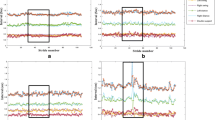Abstract
The manifestations of Parkinson’s disease (PD) are multifold. One of the manifestations is via the motor movements of a person. With a lot of data available from the Parkinson’s Progressive Markers Initiative (PPMI), the data can be analyzed and predictive analysis can be done. The goal of the effort is to identify the dominant features along with the preeminent machine learning (ML) algorithm that can determine whether a person has Parkinson’s disease or not. In this work, we have used the gait data of a person for motor movement along with the patient’s diagnostic information. Feature selection analysis using correlation coefficient is done on the gait data to provide improved accuracy. Further, those features are applied to the ML algorithms. Our experimental results show LightGBM and Xgboost provided the best result with an accuracy of 91.83%, followed by Extra tree classifier and Logistic Regression with an accuracy of 90.81%.
Access this chapter
Tax calculation will be finalised at checkout
Purchases are for personal use only
Similar content being viewed by others
References
Davie, C.A.: A review of Parkinson’s disease. Br. Med. Bull. 86(1), 109–127 (2008)
Dauer, W., Przedborski, S.: Parkinson’s disease: mechanisms and models. Neuron 39(5), 899–909 (2003)
Informatics, H.: The Role of Data Analytics in Health Care. University of Pittsburgh (2021)
The Parkinson Progression Marker Initiative (PPMI). Prog. Neurobiol. 95(4), 629–635 (2011). https://doi.org/10.1016/j.pneurobio.2011.09.005
Simuni, T., Caspell-Garcia, C., et al.: How stable are Parkinson's disease subtypes in de novo patients: Analysis of the PPMI cohort? Parkinsonism Relat. Disord. 28, 62–67 (2016)
Pahuja, G., Nagabhushan, T.N., Prasad, B.: Early detection of Parkinson’s disease by using SPECT Imaging and Biomarkers (2018)
Kim, R., Lee, J., et al.: Presynaptic striatal dopaminergic depletion predicts the later development of freezing of gait in de novo Parkinson's disease: an analysis of the PPMI cohort. 51, 49–54 (2018)
Craig, C.E., Jenkinson, N.J., et al.: Pedunculopontine nucleus microstructure predicts postural and gait symptoms in Parkinson's disease. Mov. Disord. 35(7), 1199–1207 (2020)
Nudelman, K.N.H., Xiong, Y., et al.: Dystonia-Parkinsonism gene variants in individuals with parkinsonism and brain scans without evidence for dopaminergic deficit (SWEDD). MedRxIv (2022)
Bonaccorso, G.: Machine Learning Algorithms. Packt Publishing, UK (2017)
Author information
Authors and Affiliations
Corresponding author
Editor information
Editors and Affiliations
Rights and permissions
Copyright information
© 2023 The Author(s), under exclusive license to Springer Nature Switzerland AG
About this paper
Cite this paper
Saravanan, C., Samantaray, A., Alex, J.S.R. (2023). Multimodal Analysis of Parkinson’s Disease Using Machine Learning Algorithms. In: Abraham, A., Pllana, S., Casalino, G., Ma, K., Bajaj, A. (eds) Intelligent Systems Design and Applications. ISDA 2022. Lecture Notes in Networks and Systems, vol 716. Springer, Cham. https://doi.org/10.1007/978-3-031-35501-1_47
Download citation
DOI: https://doi.org/10.1007/978-3-031-35501-1_47
Published:
Publisher Name: Springer, Cham
Print ISBN: 978-3-031-35500-4
Online ISBN: 978-3-031-35501-1
eBook Packages: Intelligent Technologies and RoboticsIntelligent Technologies and Robotics (R0)




